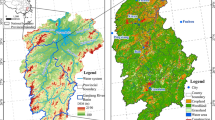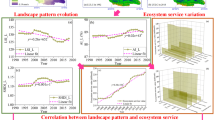Abstract
The Poyang Lake Region (PLR) is well known for its ecological and economic importance. This paper first analyzed the changes in land use/land cover (LULC), followed by changes in landscape patterns and ecosystem services by landscape metrics and equivalent coefficients table method. Then, the influence of LULC change on landscape pattern and ecosystem services in both historical period (from 1990 to 2015) and future period (2030) was explored. The results showed that the area of construction land was 607.9 km2 in 1990 and 972.5 km2 in 2015. The increased construction land mainly converted from cultivated land. For the entire PLR, a higher use degree of LULC and a trend of fragmentation existed in recent years. The total ecosystem service values (ESVs) decreased by ¥2.44 × 109 from 1990 to 2015, mainly because of shrinkage of cultivated land and sharp increase in construction land. It was predicted that the areas of construction land and waterbody would increase by 34.6% and 2.2% compared with those in 2015. These changes would lead to more regular in patch shape, longer in patch edge, less connectivity of patches, and an increase of ¥6.2 × 108 ESVs in 2030.










Similar content being viewed by others
Data availability
The datasets supporting the conclusions of this article were obtained from Resource and Environment Data Cloud Platform (RESDC) (http://www.resdc.cn/).
References
Arowolo AO, Deng X, Olatunji OA, Obayelu AE (2018) Assessing changes in the value of ecosystem services in response to land-use/land-cover dynamics in Nigeria. Sci Total Environ 636:597–609
Balatsky AV, Balatsky GI, Borysov SS (2015) Resource demand growth and sustainability due to increased world consumption. Sustainability 7:3430–3440
Cabral P, Zamyatin A (2009) Markov processes in modeling land use and land cover changes in Sintra-Cascais, Portugal. Dyna-Colombia 76:191–198
Cao S, Lv Y, Zheng H, Wang X (2014) Challenges facing China’s unbalanced urbanization strategy. Land Use Policy 39:412–415
Chan K, Xu B (2013) Perspective on remote sensing change detection of Poyang Lake wetland. Ann GIS 19(4):231–243
Chaurasia AR (2020) Economic growth and population transition in China and India 1990-2018. China Population and Development Studies. https://doi.org/10.1007/s42379-020-00067-1
Chen W, Chi G, Li J (2019) The spatial association of ecosystem services with land use and land cover change at the county level in China, 1995-2015. Sci Total Environ 669:459–470
Coscieme L, Pulselli FM, Marchettini N, Sutton PC, Anderson S, Sweeney S (2014) Emergy and ecosystem services: a national biogeographical assessment. Ecosystem Services 7:152–159
Costanza R, d’Arge R, De Groot R, Farber S, Grasso M, Hannon B, Limburg K, Naeem S, O’Neill RV, Paruelo J, Raskin RG, Sutton P, Raskin RG (1997) The value of the world’s ecosystem services and natural capital. Nature 387(6630):253–260
Dadashpoor H, Nateghi M (2017) Simulating spatial pattern of urban growth using GIS-based SLEUTH model: a case study of eastern corridor of Tehran metropolitan region, Iran. Environ Dev Sustain 19(2):527–547
Dadashpoor H, Azizi P, Moghadasi M (2019) Land use change, urbanization, and change in landscape pattern in a metropolitan area. Sci Total Environ 655:707–719
Deng X, Huang J, Rozelle S, Zhang J, Li Z (2015) Impact of urbanization on cultivated land changes in China. Land Use Policy 45:1–7
Deng, X., & Gibson, J. (2018). Sustainable land use management for improving land eco-efficiency: a case study of Hebei, China. J Ann Oper Res 1-13
Eastman JR (2012) Idrisi selva tutorial. Idrisi Production, Clark Labs-Clark University 45:51–63
Englund O, Berndes G, Cederberg C (2017) How to analyse ecosystem services in landscapes-a systematic review. Ecol Indic 73:492–504
Jahanishakib F, Mirkarimi SH, Salmanmahiny A, Poodat F (2018) Land use change modeling through scenario-based cellular automata Markov: improving spatial forecasting. Environ Monit Assess 190(6):332
Kang P, Chen W, Hou Y, Li Y (2018) Linking ecosystem services and ecosystem health to ecological risk assessment: a case study of the Beijing-Tianjin-Hebei urban agglomeration. Sci Total Environ 636:1442–1454
Kaplan JO, Krumhardt KM, Ellis EC, Ruddiman WF, Lemmen C, Goldewijk KK (2011) Holocene carbon emissions as a result of anthropogenic land cover change. The Holocene 21(5):775–791
Křováková K, Semerádová S, Mudrochová M, Skaloš J (2015) Landscape functions and their change–a review on methodological approaches. Ecol Eng 75:378–383
Kumar DS, Arya DS, Vojinovic Z (2013) Modeling of urban growth dynamics and its impact on surface runoff characteristics. Comput Environ Urban Syst 41:124–135
Liu J, Kuang W, Zhang Z, Xu X, Qin Y, Ning J, Zhou W, Zhang S, Li R, Yan C, Wu S, Shi X, Jiang N, Yu D, Pan X, Chi W (2014) Spatiotemporal characteristics, patterns, and causes of land-use changes in China since the late 1980s. J Geogr Sci 24:195–210
Liu J, Xiao W, Jiang Z, Feng X, Li X (2005) A study on the influence of landscape fragmentation on biodiversity. For Res 18(2):222–226
Mansour S, Al-Belushi M, Al-Awadhi T (2020) Monitoring land use and land cover changes in the mountainous cities of Oman using GIS and CA-Markov modelling techniques. Land Use Policy 91:104414
McGarigal, K., Cushman, S. A., & Ene, E. (2012). FRAGSTATS v4: spatial pattern analysis program for categorical and continuous maps. Computer software program produced by the authors at the University of Massachusetts, Amherst. Available at the following web site: http://www.umass.edu/landeco/research/fragstats/fragstats.html
Michishita R, Jiang Z, Xu B (2012) Monitoring two decades of urbanization in the Poyang Lake area, China through spectral unmixing. Remote Sens Environ 117:3–18
Millennium Ecosystem Assessment (2005) Ecosystems and human well-being: synthesis. Island Press, Washington DC
Ouyang W, Skidmore AK, Toxopeus AG, Hao F (2010) Long-term vegetation landscape pattern with non-point source nutrient pollution in upper stream of Yellow River basin. J Hydrol 389(3–4):373–380
Quétier F, Lavorel S, Thuiller W, Davies I (2007) Plant-trait-based modeling assessment of ecosystem-service sensitivity to land-use change. Ecol Appl 17(8):2377–2386
Rees W, Wackernagel M (2008) Urban ecological footprints: why cities cannot be sustainable and why they are a key to sustainability. Springer, Urban Ecology
Rimal B, Sharma R, Kunwar R, Keshtkar H, Stork NE, Rijal S, Rahman SA, Baral H (2019) Effects of land use and land cover change on ecosystem services in the Koshi River Basin, Eastern Nepal. Ecosystem Services 38:100963
Sakieh Y, Amiri BJ, Danekar A, Feghhi J, Dezhkam S (2015) Scenario-based evaluation of urban development sustainability: an integrative modeling approach to compromise between urbanization suitability index and landscape pattern. Environ Dev Sustain 17(6):1343–1365
Santos-Martín F, Zorrilla-Miras P, Palomo I, Montes C, Benayas J, Maes J (2019) Protecting nature is necessary but not sufficient for conserving ecosystem services: a comprehensive assessment along a gradient of land-use intensity in Spain. Ecosystem services 35:43–51
Seto KC, Reenberg A, Boone CG, Fragkias M, Haase D, Langanke T, Marcotullio P, Munroe DK, Olah B, Simon D (2012) Urban land teleconnections and sustainability. Proc Natl Acad Sci 109(20):7687–7692
Singh SK, Mustak S, Srivastava PK, Szabó S, Islam T (2015) Predicting spatial and decadal LULC changes through cellular automata Markov chain models using earth observation datasets and geo-information. Environmental Processes 2(1):61–78
Song W, Deng X, Yuan Y, Wang Z, Li Z (2015) Impacts of land-use change on valued ecosystem service in rapidly urbanized North China Plain. Ecol Model 318:245–253
UNDESAPD. (2017). Population Division. 2017. World population prospects 2017. UN Department of Economic and Social Affairs
Wu H, Hao Y, Weng J (2019) How does energy consumption affect China’s urbanization? New evidence from dynamic threshold panel models. Energy Policy 127:24–38
Xie GD, Zhen L, Lu CX, Xiao Y, Chen C (2008) Expert knowledge based valuation method of ecosystem services in China. Journal of Natural Resources 23(5):911–919
Yang X, Zheng XQ, Chen R (2014) A land use change model: integrating landscape pattern indexes and Markov-CA. Ecol Model 283:1–7
Zhao F, Li H, Li C, Cai Y, Wang X, Liu Q (2019) Analyzing the influence of landscape pattern change on ecological water requirements in an arid/semiarid region of China. J Hydrol 578:124098
Funding
This research was funded by National Key Research and Development Project grant number 2017YFC1502404; National Natural Science Foundation of China grant numbers 41890821, 51709008, and 51639005; and National Public Research Institutes for Basic R&D Operating Expenses Special Project grant number CKSF2019478.
Author information
Authors and Affiliations
Contributions
All authors contributed to the study conception and design. Method implementation and optimization, analysis, and data evaluation were performed by Jijun Xu and Yongqiang Wang. The first draft of the manuscript was written by Zhe Yuan and Bo Yan and all authors commented on previous versions of the manuscript. All authors read and approved the final sub-mitted manuscript.
Corresponding author
Ethics declarations
Ethics approval and consent to participate
Not applicable.
Consent for publication
Not applicable.
Competing interests
The authors declare that they have no conflict of interest.
Additional information
Responsible Editor: Philippe Garrigues
Publisher’s note
Springer Nature remains neutral with regard to jurisdictional claims in published maps and institutional affiliations.
Supplementary information
ESM 1
(DOCX 731 kb)
Rights and permissions
About this article
Cite this article
Yuan, Z., Xu, J., Wang, Y. et al. Analyzing the influence of land use/land cover change on landscape pattern and ecosystem services in the Poyang Lake Region, China. Environ Sci Pollut Res 28, 27193–27206 (2021). https://doi.org/10.1007/s11356-020-12320-8
Received:
Accepted:
Published:
Issue Date:
DOI: https://doi.org/10.1007/s11356-020-12320-8




